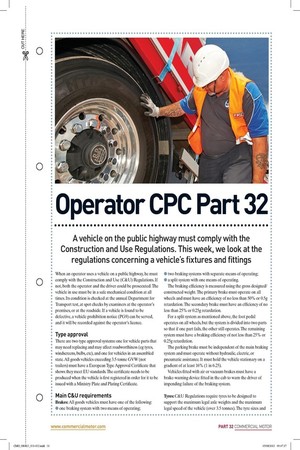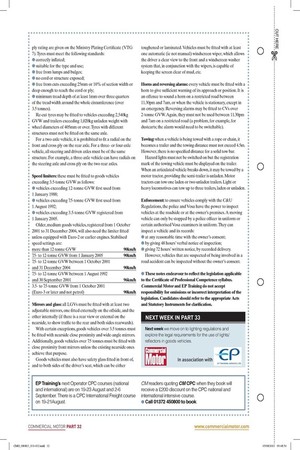Operator CPC Part 32
Page 25

Page 26

If you've noticed an error in this article please click here to report it so we can fix it.
A vehicle on the public highway must comply with the Construction and Use Regulations. This week, we look at the regulations concerning a vehicle's fixtures and fittings
When an operator uses a vehicle on a public highway, he must comply with the Construction and Use (C&U) Regulations. If not, both the operator and the driver could be prosecuted. The vehicle in use must be in a safe mechanical condition at all times. Its condition is checked at the annual Department for Transport test, at spot checks by examiners at the operator's premises, or at the roadside. If a vehicle is found to be defective, a vehicle prohibition notice (PG9) can be served, and it will be recorded against the operator's licence.
Type approval
There are two type approval systems: one for vehicle parts that may need replacing and may affect roadworthiness (eg tyres, windscreens, bulbs, etc), and one for vehicles in an assembled state. All goods vehicles exceeding 3.5-tonne GVVV (not trailers) must have a European Type Approval Certificate that shows they meet EU standards. The certificate needs to be produced when the vehicle is first registered in order for it to be issued with a Ministry Plate and Plating Certificate.
Main C&U requirements
Brakes: All goods vehicles must have one of the following: • one braking system with two means of operating; • two braking systems with separate means of operating;
• a split system with one means of operating.
The braking efficiency is measured using the gross designed/ constructed weight. The primary brake must operate on all wheels and must have an efficiency of no less than 50% or 0.5g retardation. The secondary brake must have an efficiency of no less than 25% or 0.25g retardation.
For a split system as mentioned above, the foot pedal operates on all wheels, but the system is divided into two parts so that if one part fails, the other still operates. The remaining system must have a braking efficiency of not less than 25% or 0.25g retardation.
The parking brake must be independent of the main braking system and must operate without hydraulic, electric, or pneumatic assistance. It must hold the vehicle stationary on a gradient of at least 16% (1 in 6.25).
Vehicles fitted with air or vacuum brakes must have a brake-warning device fitted in the cab to warn the driver of impending failure of the braking system. Tyres: C&U Regulations require tyres to be designed to support the maximum legal axle weights and the maximum legal speed of the vehicle (over 3.5 tonnes). The tyre sizes and ply rating are given on the Ministry Plating Certificate (VTG 7). Tyres must meet the following standards: • correctly inflated; • suitable for the type and use; • free from lumps and bulges; • no cord or structure exposed; • free from cuts exceeding 25mm or 10% of section width or deep enough to reach the cord or ply;
• minimum tread depth of at least lmm over three quarters of the tread width around the whole circumference (over 3.5 tonnes).
Re-cut tyres may be fitted to vehicles exceeding 2,540kg GVVV and trailers exceeding 1,020kg unladen weight with wheel diameters of 405mm or over. Tyres with different structures must not be fitted on the same axle.
For a two-axle vehicle, it is prohibited to fit a radial on the front and cross ply on the rear axle. For a threeor four-axle vehicle, all steering and driven axles must be of the same structure. For example, a three-axle vehicle can have radials on the steering axle and cross ply on the two rear axles. Speed limiters: these must be fitted to goods vehicles exceeding 3.5-tonne GVVV as follows: • vehicles exceeding 12-tonne GVVV first used from 1 January 1988; • vehicles exceeding 7.5-tonne GVVV first used from 1 August 1992;
• vehicles exceeding 3.5-tonne GVVV registered from 1 January 2005. Older, medium goods vehicles, registered from 1 October 2001 to 31 December 2004, will also need the limiter fitted unless equipped with Euro-2 or earlier engines. Stabilised speed settings are: more than 12-tonne GVVV 7.5to 12-tonne GVVV from 1 January 2005 7.5to 12-tonne GVVV between 1 October 2001 and 31 December 2004 7.5to 12-tonne GVVV between 1 August 1992 and 30 September 2001 3.5to 7.5-tonne GVVV from 1 October 2001 (Euro-3 or later and not petrol) 90km/h 90km/h 90km/h 96km/h 90km/h
Mirrors and glass: all LGVs must be fitted with at least two adjustable mirrors, one fitted externally on the offside, and the other internally (if there is a rear view or external on the nearside, to show traffic to the rear and both sides rearwards).
With certain exceptions, goods vehicles over 3.5 tonnes must be fitted with nearside close proximity and wide-angle mirrors. Additionally, goods vehicles over 75 tonnes must be fitted with close proximity front mirrors unless the existing nearside ones achieve that purpose. Goods vehicles must also have safety glass fitted in front of and to both sides of the driver's seat, which can be either
toughened or laminated. Vehicles must be fitted with at least one automatic (ie not manual) windscreen wiper, which allows the driver a clear view to the front and a windscreen washer system that, in conjunction with the wipers, is capable of keeping the screen clear of mud, etc.
Horns and reversing alarms: every vehicle must be fitted with a horn to give sufficient warning of its approach or position. It is an offence to sound a horn on a restricted road between 11.30pm and 7am, or when the vehicle is stationary, except in an emergency. Reversing alarms may be fitted to CVs over 2-tonne GVVV. Again, they must not be used between 11.30pm and 7am on a restricted road (a problem, for example, for dustcarts; the alarm would need to be switchable).
Towing: when a vehicle is being towed with a rope or chain, it becomes a trailer and the towing distance must not exceed 4.5m. However, there is no specified distance for a solid tow bar.
Hazard lights must not be switched on but the registration mark of the towing vehicle must be displayed on the trailer. When an articulated vehicle breaks down, it may be towed by a motor tractor, providing the semi-trailer is unladen. Motor tractors can tow one laden or two unladen trailers. Light or heavy locomotives can tow up to three trailers, laden or unladen. Enforcement: to ensure vehicles comply with the C&U Regulations, the police and Vosa have the power to inspect vehicles at the roadside or at the owner's premises. A moving vehicle can only be stopped by a police officer in uniform or certain authorised Vosa examiners in uniform. They can inspect a vehicle and its records: • at any reasonable time with the owner's consent; • by giving 48 hours' verbal notice of inspection;
• giving 72 hours' written notice, by recorded delivery. However, vehicles that are suspected of being involved in a road accident can be inspected without the owner's consent.
• These notes endeavour to reflect the legislation applicable to the Certificate of Professional Competence syllabus. Commercial Motor and EP Training do not accept responsibility for omissions or incorrect interpretation of the legislation. Candidates should refer to the appropriate Acts and Statutory Instruments for clarification.









































